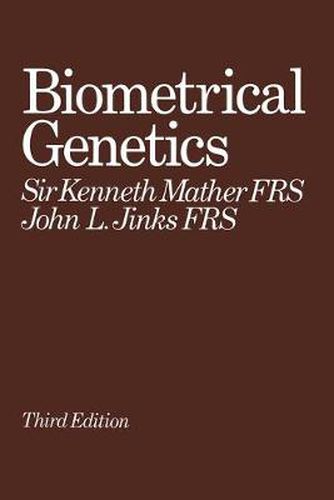Readings Newsletter
Become a Readings Member to make your shopping experience even easier.
Sign in or sign up for free!
You’re not far away from qualifying for FREE standard shipping within Australia
You’ve qualified for FREE standard shipping within Australia
The cart is loading…






This title is printed to order. This book may have been self-published. If so, we cannot guarantee the quality of the content. In the main most books will have gone through the editing process however some may not. We therefore suggest that you be aware of this before ordering this book. If in doubt check either the author or publisher’s details as we are unable to accept any returns unless they are faulty. Please contact us if you have any questions.
The properties of continuous variation are basic to the theory of evolution and to the practice of plant and animal improvement. Yet the genetical study of continuous variation has lagged far behind that of discontinuous variation. The reason for this situation is basically methodological. Mendel gave us not merely his principles of heredity, but also a method of experiment by which these principles could be tested over a wider range ofliving species, and extended into the elaborate genetical theory of today. The power of this tool is well attested by the speed with which genetics has grown. In less than fifty years, it has not only developed a theoretical structure which is unique in the biological sciences, but has established a union with nuclear cytology so close that the two have become virtually a single science offering us a new approach to problems so diverse as those of evolution, development, disease, cellular chemistry and human welfare. Much of this progress would have been impossible and all would have been slower without the Mendelian method of recognizing and using unit differences in the genetic materials. These great achievements should not, however, blind us to the limitations inherent in the method itself. It depends for its success on the ability to assign the individuals to classes whose clear phenotypic distinctions reveal the underlying genetic differences.
$9.00 standard shipping within Australia
FREE standard shipping within Australia for orders over $100.00
Express & International shipping calculated at checkout
This title is printed to order. This book may have been self-published. If so, we cannot guarantee the quality of the content. In the main most books will have gone through the editing process however some may not. We therefore suggest that you be aware of this before ordering this book. If in doubt check either the author or publisher’s details as we are unable to accept any returns unless they are faulty. Please contact us if you have any questions.
The properties of continuous variation are basic to the theory of evolution and to the practice of plant and animal improvement. Yet the genetical study of continuous variation has lagged far behind that of discontinuous variation. The reason for this situation is basically methodological. Mendel gave us not merely his principles of heredity, but also a method of experiment by which these principles could be tested over a wider range ofliving species, and extended into the elaborate genetical theory of today. The power of this tool is well attested by the speed with which genetics has grown. In less than fifty years, it has not only developed a theoretical structure which is unique in the biological sciences, but has established a union with nuclear cytology so close that the two have become virtually a single science offering us a new approach to problems so diverse as those of evolution, development, disease, cellular chemistry and human welfare. Much of this progress would have been impossible and all would have been slower without the Mendelian method of recognizing and using unit differences in the genetic materials. These great achievements should not, however, blind us to the limitations inherent in the method itself. It depends for its success on the ability to assign the individuals to classes whose clear phenotypic distinctions reveal the underlying genetic differences.